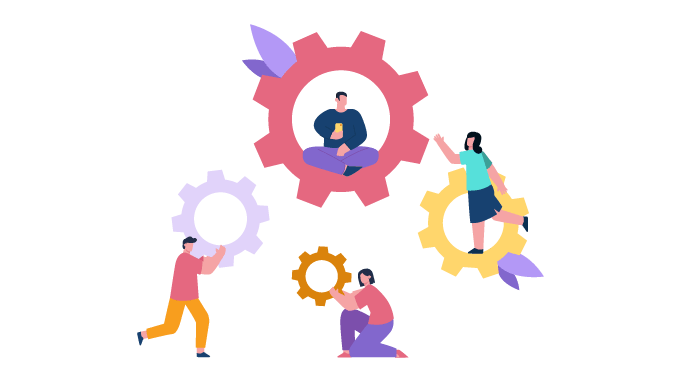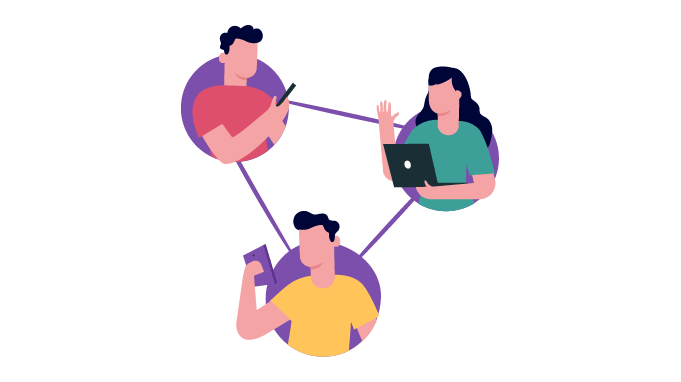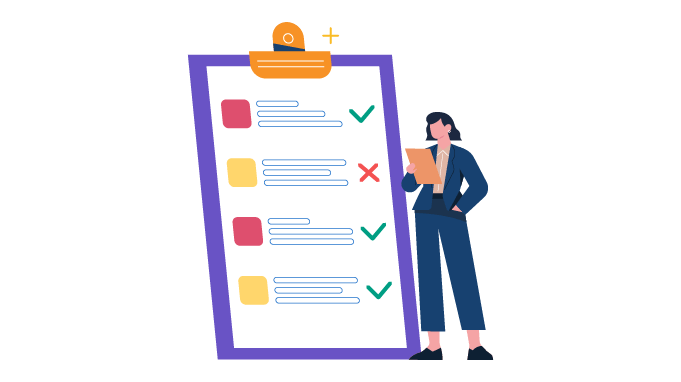Employee Experience vs Employee Engagement: Know the Difference
You must be familiar with the concepts of employee experience and employee engagement. There is a higher possibility that you consider both the same and may have used it interchangeably.
But do you know that they are two different concepts? They may have some interconnection, but they focus on different aspects.
This blog will take you through a venture that will clarify your confusion about these two concepts. They are different yet can function together in a workplace and drive the workforce.
Let us get into the details.
Key Takeaways
- What is employee experience and employee engagement
- Difference between employee experience and employee engagement
- Understanding the difference between the two
- Unleashing the powerful combination of EX and EE
- Measuring the success of EX and EE
What is Employee Experience?
Employee experience covers an employee’s overall journey within an organization throughout its tenure. It is driven by an employee-centric approach encompassing every touchpoint of an employee’s interaction with the company. These start from initial recruitment and onboarding processes to regular working experience till the employee’s exit.
A research by Harvard Business Review shows that companies who perform well on employee experience metrics also tend to perform well on customer experience metrics.
Understanding Employee Journey
The Employee journey, an integral aspect of employee experience, is also known as the employee lifecycle. It refers to the stages employees undergo during their organizational tenure, from recruitment to exit.
Understanding the journey involves mapping these stages, identifying critical touch points, and ensuring a positive experience at every step. This will give you an upper hand in building an engaging workforce.
Let us take a glance at the stages below:
-
Attraction - The initial stage is where a potential employee becomes aware of and interested in a company. The company tries to attract top talent through job postings, employer branding, career fairs, etc.
-
Recruitment - This stage covers the entire hiring process, right from sourcing candidates, screening resumes, conducting interviews to, making offers, etc. The goal here is to select the best candidates.
-
Onboarding - When candidates accept a job offer, they undergo an onboarding process to integrate into the company. This involves orientation, training, providing resources, meeting team members, etc.
-
Development - Once an employee is settled in, the focus is shifted to developing their skills, competencies, and leadership abilities through training and mentorship programs. This goes on to improve job performance.
-
Engagement - Companies take a step further to motivate and engage employees. This involves improving company culture, introducing employee recognition programs, conducting surveys to measure engagement levels, etc.
-
Retention - Companies strive to retain top talent. As a result, they offer competitive compensation, perks, work-life balance policies, advancement opportunities, etc.
-
Departure - This is the stage where employees exit the company, either voluntarily or involuntarily. The exit process includes offboarding paperwork and exit interviews.
What is Employee Engagement?
Employee engagement is employees' emotional commitment toward their organization and willingness to genuinely contribute to its cause. Engaged employees showcase their passion for work, are committed to the organization’s goals, and develop a sense of purpose toward its mission.
Employee engagement is the degree to which an employee feels that they are truly part of a company, have a voice in its decisions and feels respected
- Darryl Dioso
However, this sense of engagement does not naturally come to an employee. There are some key drivers that play a major role in igniting engagement levels in employees. And the drivers are governed by the organization.
They are as follows:
- Strong, supportive, and effective leadership
- Open and transparent communication between the managers and employees
- Encouragement and practice of regular recognition and appreciation
- Provision of career development opportunities
- Empowering and giving a sense of ownership to employees
- Fostering a positive work environment that values diversity and collaboration
- Provision of a healthy work-life balance
- Prioritizing well-being and taking suitable measures to enhance them
- Opportunities for meaningful work that instill a sense of purpose in them.
- Provision of feedback that allows employees to voice their concerns
Difference Between Employee Engagement and Employee Experience
Let us dive into the differences that exist between the two.
| Aspect | Employee Experience | Employee Engagement |
|---|---|---|
| Approach | A holistic and comprehensive strategy that considers every aspect of the employee's interaction with the organization. | Focused on specific drivers and initiatives to foster a deep emotional connection and commitment among employees. |
| Time Frame | It is a long-term and more holistic, covering the entire employment relationship. | It is immediate and ongoing, focusing on the current state of employee commitment and involvement. |
| Components | It involves the physical environment, culture, leadership, well-being technology, training, and several touchpoints throughout the employee's journey. | It primarily concerns employees' emotional connection, recognition, communication, and empowerment in their current roles. |
| Purpose | It aims to create a positive and meaningful work experience for employees at every stage of their journey. | It aims to foster a culture of deep connection and commitment to the organization's goals in employees' current roles. |
| Measurement | It can be assessed through surveys, feedback mechanisms, and observations across various stages of the employee journey. | It can be assessed through surveys and assessments focusing on the current level of passion, commitment, and involvement of employees. |
| Outcomes | Positive employee experiences contribute to higher engagement, satisfaction, and a strong employer brand. | Higher employee engagement leads to increased productivity, retention, and organizational success. |
| Flexibility and Adaptability | It requires adaptation to evolving employee needs and expectations over the course of their employment. | It requires ongoing efforts to adapt strategies, recognition, and engagement initiatives to the changing workforce dynamics. |
Understanding the Difference between EX and EE
The previous section contains a table stating the differences between the two concepts. However, the confusion between the two arises due to their similar nature, shared goals, and common drivers.
Although they may overlap over certain aspects, we should recognize and address the distinctions, leaving no room for misunderstandings. Also, it is equally important to note that this confusion may create implications for workplace strategies.
Let us see how confusion can impact the workplace:
Misalignment of Strategies
The lack of clear distinction makes organizations formulate strategies exclusively prioritizing one over the other. They overlook the holistic approach that addresses both. As a result, the misalignment has a higher tendency to lead to ineffective or incomplete initiatives.
Incomplete Understanding of Employee Needs
The lack of differentiation may result in an incomplete understanding of employees' needs and expectations. And missing out on addressing the pain points leads to disengagement and dissatisfaction.
Measurement Challenges
The lack of differentiation can hinder measuring and assessing workplace effectiveness. Inaccuracy in measuring can impact the functioning of the workplace.
Inconsistent Communication
The lack of knowledge about the differences may result in inconsistent communication. This inconsistency can directly impact employees, as it may lead to confusion caused by the absence of clear information and instructions.
Resource Misallocation
The lack of clarity may lead to the misallocation of resources. As a result, organizations invest disproportionately in areas that may not align with the employees' needs. And such wasteful spending will not contribute to a holistic and balanced employee experience and engagement strategy.
In addition, understanding the difference between employee experience and engagement has its importance and benefits. Let us dive into the discussion.
Benefits of Understanding the Difference
To begin with, understanding the difference accurately will bring more clarity, where you can avoid the negative impact or challenges discussed above. Apart from this, another set of benefits awaits your attention:
- It allows organizations to create a positive work experience that leads to higher levels of employee satisfaction
- It helps in retaining top talent by addressing their needs and expectations
- Holistic strategies considering experience and engagement contribute to a committed and motivated workforce, increasing productivity.
- Organizations can effectively adapt themselves to the evolving workforce dynamics.
The Synergy of EX & EE: A Powerful Combination

Despite the differences, employee experience and engagement as a duo can perform wonders for an organization. When they exist together, you can unleash their potential for the growth of an organization. So, let's see how these two concepts interact to foster a dynamic workforce for the employees.
A closer look will shed light on how one concept leads to another and vice versa.
For instance, When companies focus on improving employee experience, there is also a higher chance for engagement levels to rise.
- Providing training and development opportunities makes employees feel valued and helps them upskill for better growth. This boosts engagement.
- Fostering a culture of open communication and transparency makes employees feel informed, which builds trust. A trustworthy leadership is what keeps employees engaged.
- Recognizing and rewarding employees for their efforts and contributions gives them an enriching experience at work. This sense of appreciation fuels engagement.
- Offering flexibility and work-life balance showcases the care and concern for employee well-being. When employees feel that their needs are being taken care of, there is a rise in their engagement levels.
- Building a strong company culture that fosters employee collaboration gives them a sense of belonging. This makes them more engaged and connected to the team and company.
In turn, engaged employees also enhance employee experience through-
- Higher performance and productivity,
- Increased innovation and a willingness to go beyond,
- Voicing their thoughts through feedback to improve policies and work environment,
- Mentoring new hires and teammates to build a nurturing culture,
- Serving as brand ambassadors who represent a positive image of the company.
Now, let us look at instances of some companies that have harmoniously integrated both concepts to achieve a positive outcome.
Renowned for its thriving work culture, Google has prioritized EX and EE equally to reach where it stands today. The instances are as follows:
Employee Experience Initiatives:
Onsite wellness centers, flexible work arrangements, generous parental leave, and career development programs.
Engagement strategies:
Hackathons, internal innovation contests, peer-to-peer recognition programs, focus on purpose and mission.
Results:
An innovative and productive workforce, high employee satisfaction and retention, and Consistent rankings among the best places to work.
Netflix
Reigning the world as a content streaming platform, Netflix does not lag behind in prioritizing its employees through EX and EE initiatives. Let us take a look at the initiatives below:
Employee Experience Initiatives:
Unlimited vacation policy, freedom and responsibility culture, and access to cutting-edge technology.
Engagement strategies:
Transparent communication, focus on individual ownership and autonomy, strong feedback culture, emphasis on personal growth.
Results:
Highly motivated, productive employees, innovative and competitive content creation, and a thriving company culture.
Zappos
Zappos has etched its name in making its initiatives fun for its employees. The EX and EE initiatives listed below give a gist of it.
Employee Experience initiatives:
Fun and quirky company culture, focus on customer service, strong learning and development opportunities.
Engagement strategies:
Peer-to-peer recognition program, strong team bonds, company-wide retreats, commitment to fun and humor.
Results:
High customer satisfaction scores, loyal and engaged employees, strong company brand reputation.
Actionable Tips: Boosting Your EX & EE Strategies
By now, you must be clear about the importance of employee experience and engagement for an organization. You are aware of how different they are, and how, when intertwined can create greater possibilities for a company to grow. So, let us dive into some actionable steps that help boost both your EX and EE strategies.
Employee Experience
According to research by IBM, companies that score in the top 25% in employee experience get 3X the returns on their assets than companies in the bottom quartile.
Conduct Employee Journey Mapping
Identify the key touchpoints through the employee journey. Try to understand employees' perspectives at every stage. Organizations can utilize this understanding to design policies and practices that enhance the overall work experience and improve employee satisfaction.
Enhance Onboarding Processes

Give the new hires a seamless onboarding experience. Provide clear information, introduce them to the company culture, and assist them in connecting with their team members.
Promote Inclusive Culture
Foster an inclusive culture that promotes diversity and equity. Implement training programs to raise awareness and help build a respectful workplace.
Improve Communication Channels

Ensure open communication and transparency at all levels. Use multiple channels to keep employees informed about the updates and decisions.
Flexible Work Arrangements
Flexible work schedules and remote work options should be prioritized. In addition, provide the necessary tools and technology for effective remote collaboration.
Create a Positive Team Environment
Encourage building positive relationships within teams by making employees collaborate often and engaging in team-building activities.
Updated with workplace trends
With technological advances and workplace evolution on the rise, employees will have expectations from their organization to shape their employee experience accordingly.Hence, you should consider adapting your company culture to the demanding changes.
Employee Engagement
Define Clear Organizational Goals
Make sure to communicate a clear vision and mission to all employees. Guide them in a way where they can align their goals with the organization.
Effective Leadership Development
Investing in leadership development programs will assist leaders in inspiring, communicating, and supporting their teams.
Encourage Autonomy and Empowerment
Build an environment that values employees' inputs and encourages them to practice autonomy. This autonomy allows them to take a genuine interest in the company’s growth and ignite them to make sound decisions.
Provide Opportunities for Growth
Career development opportunities are necessary for your employees' growth. Ensure training, mentorship, and coaching are provided to help employees advance in their careers.
Regular Performance Feedback
Implement regular performance reviews and feedback sessions. Feedback allows them to voice their thoughts and simultaneously work on themselves.
Recognition and Rewarding Programs

Build an environment where recognition and rewards are encouraged and practiced. Celebrate individual and team efforts and accomplishments. This form of appreciation boosts employees' morale and productivity.If you want a suitable platform to make recognition part and parcel of your workplace, Vantage Rewards and Recognition is an efficient choice.
Employee Well-being

Ensure a work environment that prioritizes the health and well-being of employees through activities and challenges. This will keep them active and engaged in work.
Continuous Improvement Culture
Foster a culture of continuous improvement by encouraging employees to contribute ideas for innovation.
The Final Round: Measuring Your Success

You have prioritized employee experience and engagement and have taken actionable steps to bring out the best in your organization. But how are you supposed to determine the success? Until and unless you measure it, you won’t be able to derive the result. This is where the importance of tracking and measuring comes in. This will give you an insight into how your organization is performing and where you need to improve.
Let us dive into the importance of tracking and measuring:
-
Tracking employee experience and engagement will help you identify the pain points. Addressing and working on them will aid you in making informed decisions suitable for the company’s growth.
-
Both provide critical insights into the organization and workforce’s health and functioning. There are several metrics taken under consideration for measuring. A dip in any metrics can signal an emerging problem that will eventually impact performance and retention. However, tracking them regularly will help you intervene before the issues become severe.
-
The insights derived in the form of data suggest actions for improvement.
-
As discussed above, although different, these two concepts are interconnected. As a result, monitoring and keeping track of both will provide you with a holistic view of the workforce.
-
Taking necessary action from the gathered data can help you attract, retain, and motivate employees. And making them feel valued and invested is a significant advantage for the company.
How to Measure Employee Experience and Engagement
You can leverage various methods to carry on with your evaluation of both concepts effectively. They will serve your true purpose.
Employee Engagement Surveys

These surveys are particularly designed to measure how much employees are invested in their roles and the organization’s goals. Key areas you can explore are job satisfaction, support opportunities, recognition, manager effectiveness, and alignment with company values. In addition, opting for anonymous surveys will fetch you honest responses.
Examining the Entire Employee Life Cycle
To gather a comprehensive view of employee experience, you must understand how your workers perceive its different stages, from onboarding to exit. For this, you can conduct new hire satisfaction surveys, stay interviews, exit interviews, and journey mapping. The insights gathered shed light on employees' feelings at several touchpoints of their organization’s journey.
Analyzing relevant HR metrics
You can further analyze the different HR metrics, such as retention rate, turnover rate, absenteeism rate, performance metrics, training effectiveness, etc, for a detailed overview.
Conducting Frequent Measurements
Instead of only sticking to annual reviews or feedback, opt for regular and frequent analysis of different aspects of employee experience and engagement. This will allow you to intervene before things turn sour. Pulse surveys are the best option to conduct such frequent surveys. That way, you can continuously enhance and evolve the work environment for your employees.
Engaging in Open Dialogues

Cultivate an environment where employees are comfortable sharing their thoughts, concerns, and suggestions. Regular feedback sessions, one-on-one discussions with managers, and town hall meetings can give you a proper insight into the employees' mindset.
Conclusion
By now, you must have gained clarity about the differences that exist between employee experience and employee engagement. Along with the differences, you have understood how they can bring out the best in the company when merged.
Now, it is your chance to utilize the information to the fullest and churn out a suitable outcome from both employee experience and employment.
FAQs
What factors contribute to a positive employee experience?
Positive employee experience is driven by factors like workplace culture, career development activities, work-life balance, and overall support the organization provides.
What role does leadership play in shaping both EX and EE?
Strong leadership is entrusted with establishing a culture of trust, strengthening open communication, and staying committed to employees’ well-being and success.


















